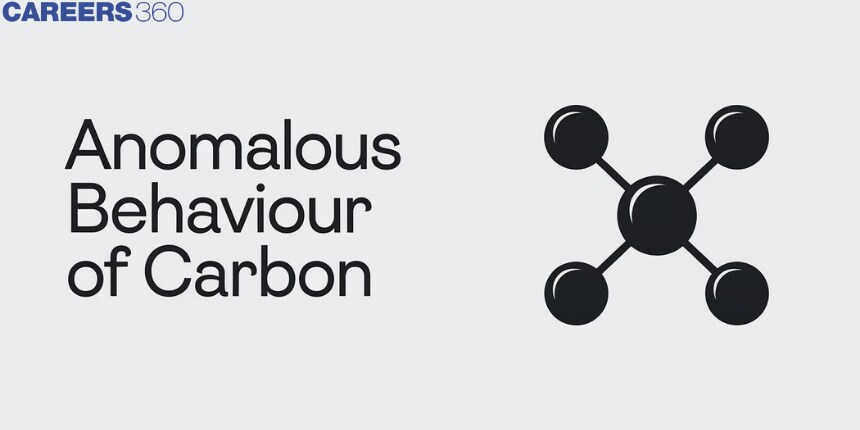Anomalous Behaviour of Carbon: Tetravalency, Electronegativity, Catenation, Adaptive forms
Carbon, which is present on Earth in many different forms, makes up 0.02 per cent of the crust. When considering the group, the first thing that springs to mind is carbon because it is so distinct from the others. Carbon exhibits peculiar behavior due to several properties, including the absence of d-orbitals, in addition to its unusual size, high electrification, high ionisation energy, and lack of d-orbitals. Compared to other elements in the same family as carbon, such as oxygen, carbon-based compounds have high melting and boiling temperatures.
This Story also Contains
- Anomalous Behaviour Of Carbon
- The Following Are The Causes Of Carbon's Unusual Behaviour: Tetravalency Of Carbon
- The Small Carbon Size
- Electronegativity
- Catenation
- Adaptive Forms
- There Are Two Categories Of Carbon Compounds
- Conclusion

Anomalous Behaviour Of Carbon
The first element in group 14, carbon, differs from the other elements in its group in several ways, leading to behaviour that is unusual for the element.
Carbon is different from the other group members, just like the first members of their respective groups. Carbon exhibits this behaviour mostly as a result of its:
The atom's small size
high-voltage negative
High ionization enthalpy
The absence of D- Orbital
The Following Are The Causes Of Carbon's Unusual Behaviour: Tetravalency Of Carbon
Tetravalency, or the ability to share four electrons to complete an octet, allows for the bonding of carbon to four separate monovalent atoms. With oxygen, nitrogen, hydrogen, halogens, and other elements, carbon can be found in a wide range of compounds, each of which has unique qualities and features.
It can only fit four pairs of electrons in its valence shell since only the s and p orbitals are available. As a result, the covalence can only be four, but other group members have higher covalence due to the presence of d-orbitals.
The Small Carbon Size
The majority of carbon's characteristics is also a result of its small size. Due to its small size, carbon produces highly stable compounds. The nucleus may successfully hold on to both bonded and unbonded electrons due to its modest size.
In summary, carbon differs from other elements due to its tetravalency, small size, and catenation property; as a result, a whole branch of chemistry is devoted to the study of this type of compound.
Electronegativity
Carbon is capable of more than just this; it can also form several ppi - ppi bonds with other molecules and with itself. This might be a result of its diminutive size and high electronegativity. Some of them would be ![]() .
.
Catenation
The capacity of similar atoms to form covalent connections with one another is known as catenation, and it is a feature of carbon. This is brought on by the carbon atoms' smaller size, stronger electronegativity, and distinctive strength of carbon-carbon bonds. The strength of the element-element bond has a significant impact on the catenation property. Since the C-C bond has a relatively high bond energy, carbon can form long, branching or straight chains as well as rings of various sizes and shapes. However, the tendency for catenation decreases in the order as we move down the group because the element-element bond energies rapidly decrease.
Adaptive Forms
Carbon atoms can exist in four different allotropes, including diamond, graphite, lead, and Buckminsterfullerene, thanks to their catenation feature. Diamond is an allotrope of carbon that is more challenging to work with than the other elements in Group 14 as a whole.
To summarise, carbon differs from other elements due to its tetravalency, tiny size, and catenation qualities. As a result, a sizable section of chemistry is devoted to the study of this kind of chemical.
There Are Two Categories Of Carbon Compounds
Compounds of Saturated Carbon: These are compounds in which a chain or ring of carbon atoms is held together by only a single bond. The most common saturated chain carbon molecules are alkanes. Ethane belongs to the alkane family chemically speaking.
Compounds of Unsaturated Carbon: These are substances in which a chain or ring-shaped arrangement of double or triple bonds connects the carbon atoms. The most prevalent unsaturated chain carbon compounds are alkynes and alkenes, in which carbon atoms are joined by double bonds. Alkenes include ethene.
Conclusion
Group 14 of the periodic table contains carbon. Since very early times, it has been known as graphite, diamond, coal, and charcoal. It is an essential part of every biological system. A vast range of substances contains carbon. Inorganic and organic carbon compounds can be divided into two groups. The tiny atomic size, enhanced electronegativity, and lack of vacant d orbitals in the valence shell of a carbon account for its unusual behaviour.
Frequently Asked Questions (FAQs)
When considering the group, the first thing that springs to mind is carbon because of how distinctive it is. Due to several characteristics, most notably the absence of d-orbitals, carbon exhibits unique behaviour.
A crucial property of materials is allotropy, which serves as the foundation for heat-treating a vast range of technological materials. The most popular allotropic engineering materials are iron and its alloys.
Carbon cannot form C4+ because losing 4 electrons would demand a significant amount of energy, leaving a carbon cation with six protons in its nucleus and just 2 electrons remaining.
There is no 4 bond formed between carbon atoms because of the carbon electron orbitals. Since it already has four valence electrons, it needs four additional electrons to complete its outer energy level.
Always tetravalent and frequently tetrahedral is carbon.
The carbon atoms that makeup diamond, graphite, and graphene can also be connected in various ways. We now move on to molecules made up of carbon and other elemental atoms.